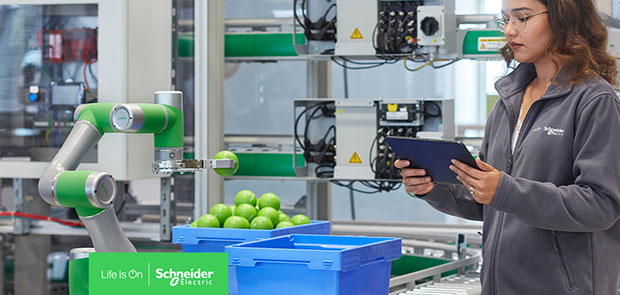Warehouse and logistics operations are being tasked with handling higher demand with less staff, all while reducing energy consumption and showing a commitment to sustainability best practices, writes Dave Sutton – Product Marketing Manager for Industrial Automation; Schneider Electric. All business sectors have a touchpoint with logistics in one way or another, meaning any advancement at this crucial stage in the supply chain will have far-reaching implications, supporting UK businesses as they grow and compete on the world stage.

Making sense of logistics requires a single digital thread that joins the dots on the varied and disparate OT and IT systems, an approach that delivers value for end users, systems integrators, and OEMs serving the sector.
Next-generation automation
Unlike other industrial settings, warehousing and logistics was a sector to quickly embrace robotics and automation to improve efficiencies and address growing labour and skills shortages. OEMs, system integrators, and end users also faced rising warehouse and energy costs and learned to leverage technologies to maximise the use of available space by creating a complex mix of systems. So, despite the sector’s readiness to deploy new technology, it faces an integration challenge, requiring a solution that empowers logistics professionals, OEMs, and System Integrators to deploy best-in-class solutions for both new and legacy facilities.
The solution to this is a new way of automating, based on the principles of Universal Automation and the IEC 61499 standard, which has redefined what is meant by ‘plug and produce’ software. Logistics end users, OEMs, and System Integrators can design applications using software components which are independent from the hardware on which they execute. This is known as the software-centric approach. By combining it with an ecosystem of automation users and technology vendors sharing a common technology standard, it unlocks the next generation of capabilities for logistics settings. It overcomes the challenges presented by a combination of new and legacy assets, all operating on locked in software sub-systems.
The 2024 UK logistics digital infrastructure report is an important resource, assessing how ready the logistics industry is for wider digital transformation. Firstly, the logistics sector is seeing a growing skills gap, with 62.9% of companies in the sector saying their employees lack digital skills, and secondly 65.2% of the sector is calling for more support to invest in digital technology.
These two stats prove the need for a shared automation platform that can communicate across different hardware and software into one cohesive system, representing a true IT/OT convergence. New and experienced members of the workforce can quickly gain actionable insights in real time, and OEMs and system integrators can deliver end-to-end logistics solutions using the same platform. All parties involved know that their chosen solution is future-proofed against future technology additions to their facility, supporting logistics businesses throughout the ongoing digital transformation journey.
As an automation system, EcoStruxure Automation Expert (EAE) from Schneider Electric supports this vision of universal automation. As the world’s first software-centric automation system EAE delivers value for logistics OEMs, system integrators, and end users by removing the barriers of proprietary systems and connecting beyond components. EcoStruxure Automation Expert empowers the logistics sector to seamlessly integrate the latest robotics with existing assets to create a smart facility that continuously improves reliability, productivity, and sustainability.
Moving value
As mentioned previously, robotics is an area where logistics businesses are leading the way; deploying picking, sorting, and transporting solutions to streamline operations while supporting scalability. Logistics end users, OEMs, and system integrators looking to take this to the next stage should explore advanced carrier transport systems. While this is not a new technology for the sector, advanced options are being coupled with digital twin technology to deliver flexibility, ensuring that testing can be completed in a virtual environment before the hardware is installed. Just like with the shared automation platform, the right solution will seamlessly integrate with existing assets and remove the integration challenges that are common in the sector. Again, this empowers logistics businesses to modify processes, respond to demand, and future proof operations with scalability in mind.
As an example, Schneider Electric’s Lexium MC12 multi carrier is a modular system that increases the performance and flexibility of logistics operations by up to 50%. Carriers move independently on track systems, with material being placed or grouped at the right time and position, enabling different formats to be placed on the same machine. For OEMs and system integrators, that agility extends the value that can be offered to the end user, providing ongoing maintenance and process changes as a service. The modularity of the MC12 can help them to maximise resource use and continuously optimise a logistics facility.
Almost across the board, businesses are under pressure to improve sustainability. The logistics sector is in a unique position as it acts as a connection between multiple sectors, representing a large piece of the sustainability puzzle. Any improvements in efficiency, whether from deploying advanced carriers or creating a digital thread through existing assets, will have wide reaching implications. Schneider Electric supports logistics OEMs, System Integrators, and end users by being the single-source partner for all applications, representing an end-to-end solution that enables the supply chain of the future.
Schneider Electric
Schneider’s purpose is to create impact by empowering everyone to make the most of our energy and resources, bridging progress and sustainability for all. At Schneider, we call this Life Is On.
Our mission is to be the trusted partner in Sustainability and Efficiency.
We are a global industrial technology leader bringing world-leading expertise in electrification, automation and digitisation to smart industries, resilient infrastructure, future-proof data centres, intelligent buildings, and intuitive homes. Anchored by our deep domain expertise, we provide integrated end-to-end lifecycle AI enabled Industrial IoT solutions with connected products, automation, software and services, delivering digital twins to enable profitable growth for our customers.
We are a people company with an ecosystem of 150,000 colleagues and more than a million partners operating in over 100 countries to ensure proximity to our customers and stakeholders. We embrace diversity and inclusion in everything we do, guided by our meaningful purpose of a sustainable future for all.




Comments are closed.